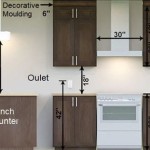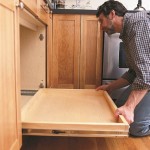Organizing Your Kitchen Cabinets and Drawers: Essential Aspects
Maintaining an organized kitchen is crucial for efficient food preparation and a clutter-free environment. By implementing practical organization strategies, you can transform your kitchen into a well-structured and functional space. Here are the essential aspects to consider when organizing your kitchen cabinets and drawers:
1. Decluttering:
Begin by removing everything from your cabinets and drawers. Sort through your items and discard anything you no longer need or use. Donate or discard duplicates, broken appliances, and expired food. This first step will create space for a more organized system.
2. Categorize and Group:
Group similar items together to make them easier to find. For example, store all your pots and pans in one cabinet, utensils in a drawer, and food items in a pantry. Categorizing items will reduce clutter and make it easier to keep your kitchen organized in the long run.
3. Vertical Storage:
Maximize vertical space by using shelf dividers, stackable containers, and drawer organizers. These tools allow you to store more items in a smaller area, making it easier to find what you need. Vertical storage is particularly useful for deep cabinets or drawers.
4. Optimize Drawer Space:
Drawer organizers can help you create compartments within drawers, allowing you to store different types of items separately. These organizers can be customized to fit your drawer size and specific needs. Consider using dividers for cutlery, silverware, and cooking utensils.
5. Utilize Cabinet Doors:
The inside of cabinet doors can be a valuable storage space. Install door-mounted organizers to store spices, small jars, or frequently used utensils. This frees up shelf space and keeps your most-used items within easy reach.
6. Choose the Right Storage Containers:
Clear containers allow you to see what's inside without having to open them. Choose containers that are the right size for the items you're storing to avoid overcrowding and wasted space. Also, consider containers with lids to protect the contents from dust and spills.
7. Label Everything:
Labeling cabinets, drawers, and containers will make it easy to identify what's inside. This is particularly helpful for pantry items or infrequently used appliances. Using a label maker or handwritten labels will help you maintain order and find what you need quickly.
8. Regularly Clean and Maintain:
Maintaining an organized kitchen is an ongoing process. Regularly clean your cabinets and drawers to remove dust and spills. Take inventory of your items every few months and discard or donate anything you no longer need. By keeping your kitchen organized, you'll save time, reduce stress, and enjoy a more functional cooking space.

How To Organize Kitchen Drawers And Cabinets Shannon Gold Design

How To Organize Kitchen Drawers Hallstrom Home

How To Organize Kitchen Cabinets And Drawers For Good

How To Organize Your Kitchen Cabinets Step By Project The Container

How To Organize Kitchen Cabinets And Drawers For Good

40 Best Ideas For How To Organize Kitchen Cabinets

How To Organize Your Kitchen Cabinets Step By Project The Container

How To Organize Your Kitchen Cabinets And Drawers She Gave It A Go

How To Organize Your Kitchen Cabinets In 3 Simple Steps Practical Perfection

Insiders Tip How To Organize The Kitchen Cabinets Smart Way Edgewood Cabinetry
Related Posts








